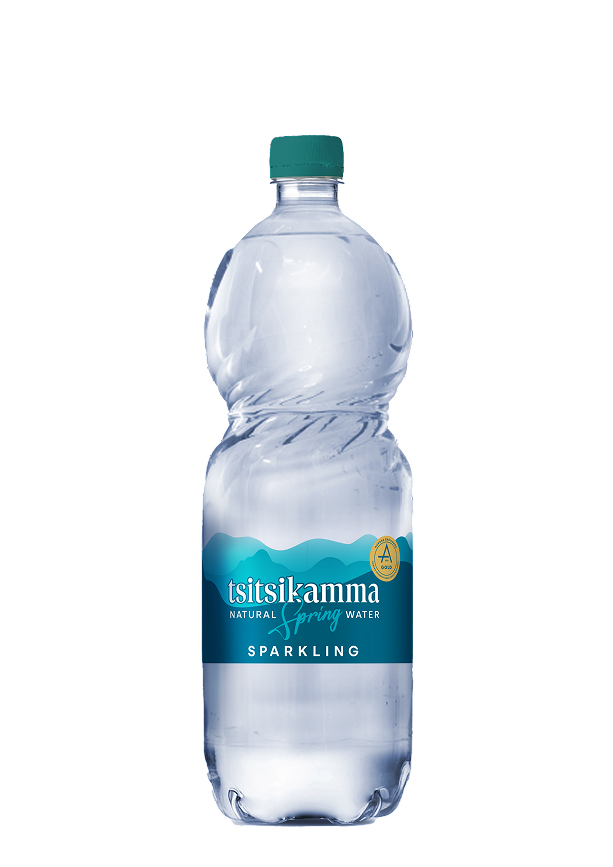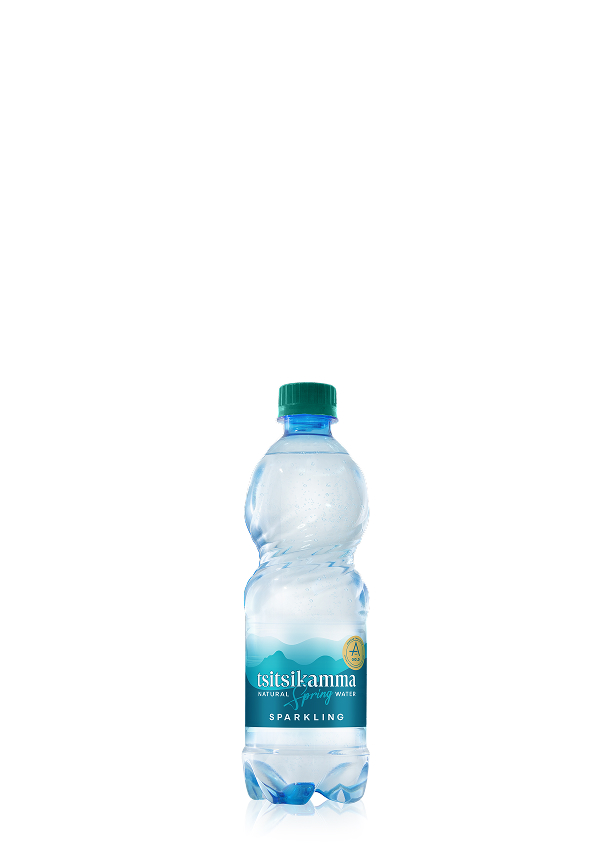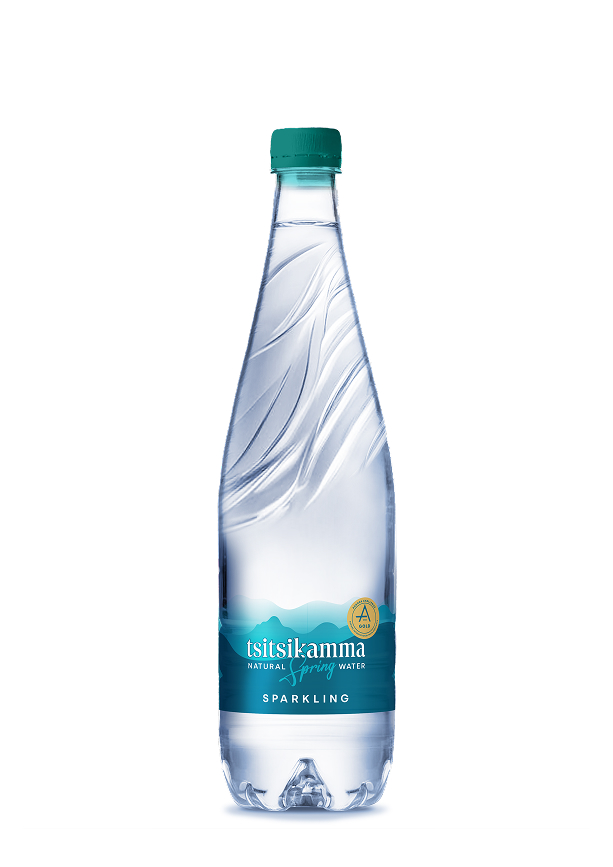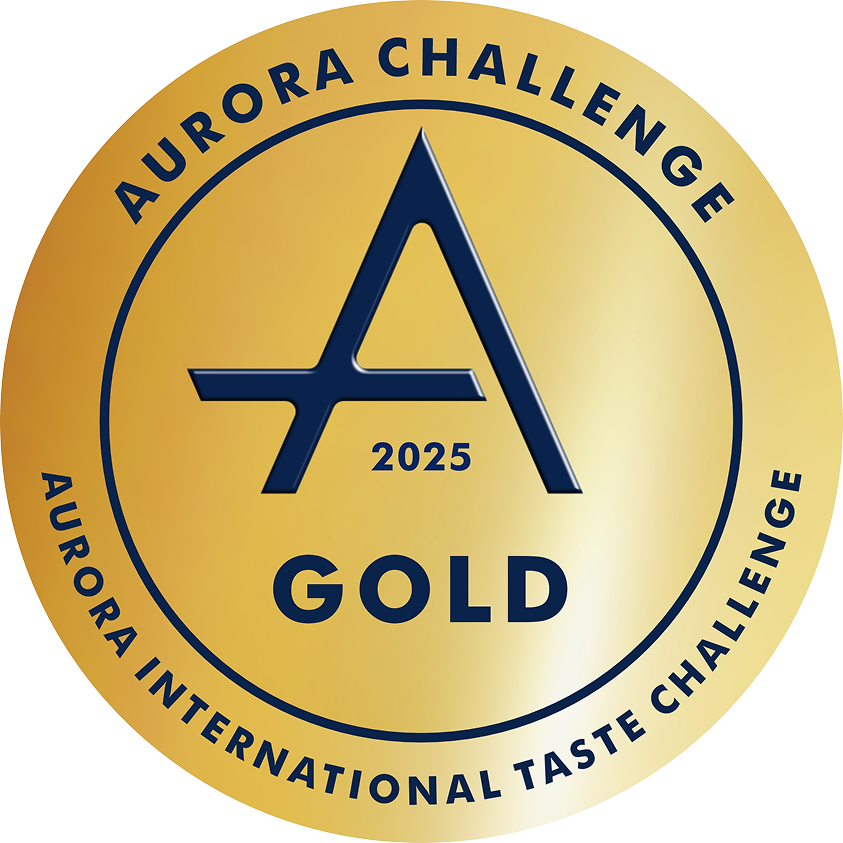A Little Sparkle
A Lot of Freshness.
Effervescent and refreshing, our Sparkling Spring Water captures the natural purity of Tsitsikamma and enhances it with a delicate, uplifting fizz. Perfect for elegant entertaining or everyday enjoyment, it’s a guilt-free alternative to sugary soft drinks—pure, crisp, and proudly local.
- Infused with fine bubbles for a refined finish
- No sugar, no sodium, no artificial ingredients
- 'Refreshing on its own or with a twist of citrus, mint or your favourite berries



Mineral Composition mg/L
*Subject to seasonal fluctuations
- Calcium: <0.2
- Magnesium: 3.5
- Sodium: 22
- Potassium: <0.4
- Chloride: 40
- Sulphate: 5.3
- Alkalinity as CaCO3: <10
- Nitrate: <0.2
- Fluoride: <0.2
- Total Dissolved Solids: 105
- pH: 5.2 (Uncarbonated)
pH myths
Tsitsikamma Spring Water emerges from a quartzitic aquifer within the Table Mountain Sandstone that forms the pristine Tsitsikamma Mountain Range. As the groundwater travels through natural fractures in the rock, it absorbs the unique mineral characteristics of the surrounding geology. This journey results in a naturally low pH of around 5.2 – typical of water filtered through this type of parent material.
While many online sources debate the health benefits of alkaline diets, current scientific research does not support the idea that drinking alkaline water—or altering your body’s pH – has any proven medical benefit. The human body tightly regulates its internal pH, particularly in the blood and extracellular fluids, regardless of what you eat or drink.
In short, your body maintains its own balance. What matters most is hydration – and Tsitsikamma Spring Water delivers that, naturally.
What is TDS?
TDS, or Total Dissolved Solids, measures the concentration of naturally occurring minerals and trace elements dissolved in water. As Tsitsikamma Spring Water flows through ancient layers of quartzitic rock, it absorbs essential minerals like calcium, magnesium and potassium contributing to its sweet taste and natural balance.
Does Tsitsikamma Spring Water contain Fluoride?
We don’t add fluoride (or anything else for that matter) to Tsitsikamma Spring Water. What you get is pure spring water, just as Mother Nature intended. The mineral composition listed on our label reflects only the naturally occurring minerals present in our source.
The fluoride content is naturally low, at less than 0.2 mg/L, well below the levels typically found in fluoridated municipal water.
Is Tsitsikamma Spring Water filtered?
Yes, Tsitsikamma Spring Water is gently filtered and UV treated to meet industry health and safety standards. These processes do not alter the mineral composition in any way, so you still enjoy water exactly as Mother Nature intended – clean, safe, and naturally balanced.
What is an eco-bottle?
An eco-bottle is designed to reduce environmental impact through sustainable materials and improved recyclability.
At Tsitsikamma Spring Water, our eco-friendly bottle contains 30% recycled PET plastic and is 100% recyclable, including the lightweight bottle, cap, and label.
- The light blue bottle colour helps maintain clarity and appeal while still being recyclable.
- The HDPE cap floats during the recycling separation process, making it easy to recover.
- The wraparound label uses minimal glue, which simplifies removal during recycling.
- Tethered caps stay attached to reduce litter.
You keep recycling. We’ll keep reusing. Together, we make a difference.
How is PET recycled?
Once discarded, PET bottles are collected, crushed, and baled before being transported to a PET recycling and reprocessing facility. There, they undergo a series of steps:
- Colour sorting
- Washing and granulating
- Re-washing
- Extrusion into strips
- Cutting into pellets
These recycled PET pellets are then used to manufacture new products—helping reduce waste and conserve resources.
How can recycled PET be used?
Recycled PET is a highly versatile material that can be transformed into a wide range of new products, helping reduce waste and support a circular economy.
Some common uses include:
- Reusable items: carry bags, furniture, and walkways
- Home and lifestyle: roof insulation, pillow and duvet filling, cushions, carpets and upholstery
- Clothing and textiles: fabric for T-shirts, jeans (about 12 x 500ml bottles per pair), fleece jackets and sportswear
- Consumer goods: athletic shoes, luggage and industrial strapping
- Packaging and transport: crates, pallets, automotive parts and even new PET containers for food and non-food products
Recycling PET not only extends the life of plastic, it transforms it into something new and useful.
Why not use biodegradable plastics?
Biodegradable Plastics: A Recycling Misconception
Biodegradable plastics are not recyclable and therefore can’t be used in existing recycling chains as they will CONTAMINATE entire recycling systems. These materials therefore need to be kept apart from conventional plastics. If people don’t know this and discard biodegradable plastic together with recyclable plastic, it results in all that plastic (which was designated for recycling) being rejected and dumped.
The misconception that biodegradable plastics simply ‘disappear’ over time may encourage littering, under the false belief that they leave no trace.
Furthermore, not all biodegradable plastics break down cleanly. Many release harmful by-products, such as methane, during decomposition – contributing to greenhouse gas emissions rather than reducing them.
Are there BPA's in Tsitsikamma Spring Water bottles?
No, our bottles do not contain Bisphenol A (BPA).
BPA is not used in the production of PET (polyethylene terephthalate)—the material we use for our bottles. It is also not a chemical building block in any part of the PET manufacturing process.
Why plastic (PET) bottles, not glass?
While glass is often perceived as eco-friendly, its environmental impact tells a different story—especially in the context of water bottling.
- High Energy Use: Glass is produced at extremely high temperatures (2,600–2,800°F), leading to significantly higher fossil fuel emissions compared to PET.
- Heavy and Rigid: Glass bottles are heavier and bulkier, resulting in a much larger carbon footprint during transport—both before and after use.
- Water & Energy Intensive: Reusing glass bottles requires extensive washing and sterilisation—raising serious sustainability concerns in a water-scarce country like South Africa.
- Fragile & Hazardous: Glass can easily break, posing safety risks and creating waste challenges.
By contrast:
- Lower Carbon Footprint: Tsitsikamma Spring Water produces PET preforms and bottles onsite, dramatically reducing emissions from transport and logistics.
- Efficient Recycling: Empty PET bottles are lightweight, crushable, and baled for efficient transport to recycling centres—minimising their environmental impact.
- Safe, Sustainable, and Practical: PET is 100% recyclable, safe for use, and far more sustainable across its lifecycle when managed responsibly.
